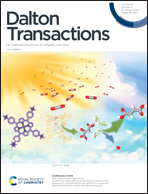Aryl selenonium vs. aryl sulfonium counterions in polyoxometalate chemistry: the impact of Se+ cationic centers on the photocatalytic reduction of dichromate†
Abstract
A selenonium organic counter ion has been used in polyoxometalate chemistry to develop a new aryl selenonium polyoxometalate (POM) hybrid, and its photocatalytic properties have been explored in comparison with an aryl sulfonium POM-hybrid counterpart for the first time. The chalcogenonium counterions, namely, methyldiphenylsulfonium trifluoromethane sulfonate (MDPST) and methyldiphenylselenonium trifluoromethane sulfonate (MDPSeT), and their octamolybdate ([Mo8O26]4−) hybrids, 1 and 2, with the general formula (C13H13X)4[Mo8O26] (where X = S for 1 and Se for 2) were synthesized and characterized. Hybrids 1 and 2 vary in their chalcogenonium cationic center (S+vs. Se+), which enabled a direct comparison of their photocatalytic properties as a function of the cationic center. The photocatalytic activities of hybrids 1 and 2 were tested using the reduction of dichromate (Cr2O72−) as a model reaction under UV irradiation. A 99% photocatalytic reduction of Cr2O72− with a rate constant of 0.0305 min−1 was achieved with hybrid 2, while only a 67% reduction with a rate constant of 0.0062 min−1 was observed with hybrid 1 in 180 minutes. The better catalytic performance of hybrid 2 may be correlated to the larger atomic radii of Se than S, which helps in better stabilizing the photogenerated electron–hole (e−–h+) pair on the POM cluster by polarizing its lone pair more efficiently compared to S. The catalytic recyclability was tested for up to 4 cycles using hybrid 2, and up to 98% reduction was obtained even after the 4th cycle. Recyclability tests and control experiments also indicated the generation of some elemental Se through possible cleavage of some C–Se bonds of MDPSe under prolonged UV exposure during catalysis, and the Se thus generated was found to contribute to the catalytic reduction of dichromate. This study, therefore, opens new avenues for aryl selenonium moieties and their POM hybrids for potential catalytic applications.



 Please wait while we load your content...
Please wait while we load your content...